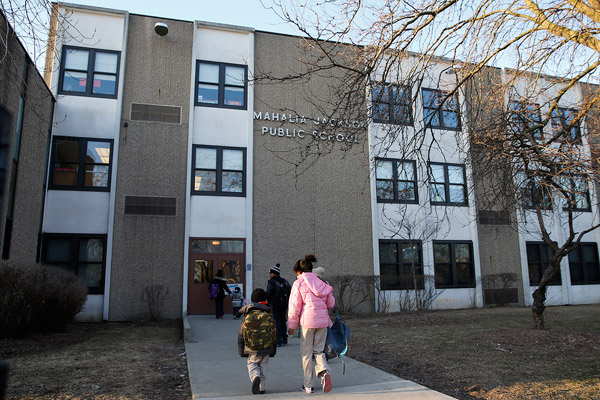
Jose M. Osorio/Chicago Tribune
The number of school closings trickling out today is unprecedented, but in the prior decade CPS closed a lot of schools. So there's precedent to bring to bear on what's to come.
* In 2009, the Consortium on Chicago School Research at the University of Chicago looked at the effect of elementary school closings from 2001-2006 on children eight years and older—specifically, on the academic effects (PDF). What they found was that things didn't change much either way. The change that did occur was about what you would expect:
Students who enrolled in schools with high average student achievement had significantly higher levels of achievement than students who enrolled in weaker schools. In reading, displaced students in the strongest receiving schools (those in the top quartile of the distribution) had an achievement level one year later that was almost a month above expected. However, students who attended some of the weakest schools in the system (those in the bottom quartile of the distribution) experienced a loss in achievement of over a month (see Figure 9). In math, the achievement level was more than two months above what was expected for students in the strongest schools, versus a loss of half a month for students in the weakest schools. The overall academic achievement of receiving schools affected math scores more than reading scores.
In other words, closing schools did improve student performance… when those students went to the best of CPS schools.
* In 2006, Elizabeth Duffrin of Catalyst Chicago looked at closings from 2002-2006, which were heavy on academic-performance closures (PDF):
This year, 67 percent of elementary school students displaced by closings were enrolled in schools on academic probation, though considerably fewer are in the worst of the bunch. Only 7 percent are now in schools where 20 percent or fewer hit targets on the Iowa Test of Basic Skills; previously 53 percent were in those schools.
Here's a big reason why the closings are almost all elementary schools, and include no high schools; the safety and discipline problems are far less dramatic, though they did occur:
Elementary schools reported fewer safety issues. Children from closed schools were often assigned to others nearby, where they often knew other kids. Those transitions tended to go more smoothly, school officials say. But in some sparsely populated areas, children were forced to walk farther into less familiar neighborhoods. At Gladstone on the Near West Side, discipline problems were serious enough last year for CPS to assign a part-time police officer, says Principal Gary Moriello. But disruptions died down this year as the displaced kids from Jefferson settled into their new school, he adds.
* That same year, the Trib looked at Clemente High School after it started getting students from then-shuttering Austin High.
Chicago has shut nine elementary schools in five years, shifting thousands of pupils into new schools in new neighborhoods. Few problems surfaced.
But high schools are far more complicated.
[snip]
Though Austin students began transferring two years ago, problems did not surface until this year, when their enrollment hit 250, school officials said.
By early October, gang warfare erupted. School officials, security guards and students say the Gangster Disciples from Austin warred with the Latino Vice Lords and Lovers for control of the school. Students were jumped outside the school as they exited for fire drills. Fistfights broke out in the hallways.
* Diane Ravitch has more in a very critical post.


